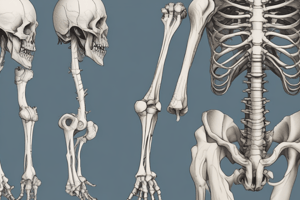Podcast
Questions and Answers
What is the greater trochanter?
What is the greater trochanter?
- It is a ligament
- It is a part of the femur (correct)
- It is a type of muscle
- It is a bone in the arm
What is the purpose of the femur head?
What is the purpose of the femur head?
- It connects to the pelvis (correct)
- It protects the muscles
- It aids in walking
- It supports the knee
What does the neck of the femur do?
What does the neck of the femur do?
- Connects the head to the shaft (correct)
- Provides attachment for ligaments
- Helps in blood production
- Encloses the joint
What is the shaft of the femur?
What is the shaft of the femur?
What is the lateral epicondyle?
What is the lateral epicondyle?
What is the medial epicondyle?
What is the medial epicondyle?
What is the intertrochanteric crest?
What is the intertrochanteric crest?
What is the lesser trochanter?
What is the lesser trochanter?
What is the nutrient foramen?
What is the nutrient foramen?
What is the linea aspera?
What is the linea aspera?
What is the adductor tubercle?
What is the adductor tubercle?
What is the intercondylar fossa?
What is the intercondylar fossa?
What is the medial condyle?
What is the medial condyle?
What is the lateral condyle?
What is the lateral condyle?
Flashcards are hidden until you start studying
Study Notes
Femur Bone Markings
-
Greater Trochanter: A large, bony prominence on the lateral side of the femur serving as an attachment site for muscles including the gluteus medius and minimus.
-
Head: The rounded, proximal end of the femur that articulates with the acetabulum of the pelvis, forming the hip joint.
-
Neck: The narrow region below the head, which connects the head to the shaft and is a common site of fractures.
-
Shaft: The long, cylindrical central part of the femur, providing strength for weight-bearing and muscle attachment.
-
Lateral Epicondyle: A small projection located on the outer side of the femur, serving as an attachment point for ligaments and muscles.
-
Medial Epicondyle: A similar small projection on the inner side of the femur, also providing an attachment site for ligaments and muscles.
-
Intertrochanteric Crest: A prominent ridge located on the posterior side of the femur, connecting the greater and lesser trochanters.
-
Lesser Trochanter: A smaller, bony prominence on the medial side of the femur, serving as an attachment point for the iliopsoas muscle.
-
Nutrient Foramen: Small openings in the femur allowing blood vessels to enter for nourishing the bone tissue.
-
Linea Aspera: A longitudinal ridge on the posterior surface of the femur that acts as an attachment site for various muscles of the thigh.
-
Adductor Tubercle: A bony protuberance on the medial epicondyle, serving as an attachment for the adductor magnus muscle.
-
Intercondylar Fossa: A deep notch between the medial and lateral condyles at the distal end of the femur, important for ligament attachment.
-
Medial Condyle: The rounded distal end on the inner side of the femur, articulating with the corresponding tibial condyle.
-
Lateral Condyle: The rounded distal end on the outer side of the femur, articulating with the lateral tibial condyle.
Studying That Suits You
Use AI to generate personalized quizzes and flashcards to suit your learning preferences.




